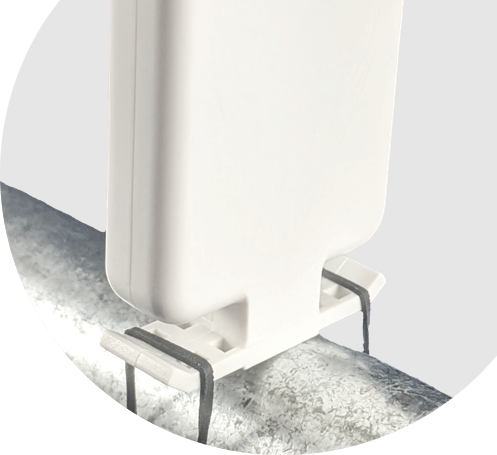What it looks like!
The leak sensor is a small device, a few centimeters wide and long, with a temperature sensitive material in the tip. When it is mounted on your water pipe, it may look like in this picture.

Where do I place it?
Place it as close to your water meter as possible. For more pictures and examples, click here.
What can it do?
The smallest water leaks may not be visible on your water bill, but for the sake of your home and your health, then let's discover such leaks before mould or fungus has destroyed your home or made your family sick.
Larger water leaks can be immediatly destructive to your home, and may grow to a large water bill too. If you stop a running toilet, which will eventually happen in all homes, then that alone should cover your expenses to the system.
As extras, avoid frozen water pipes by observing the pipe temperature, and make sure your water is fresh and without bacterias if the pipes were not used for 2 days or more.
How are leaks detected?
The leakage sensor detects small water pipe leaks and burst pipes. Small leaks, down to milliliters pr hour, can take days to detect. Larger leaks, above 5-10 liters pr hour, may take a couple of hours to detect. The precision depends a lot on your installation, and the system tries to memorize your normal water consumption before notifying you.
You can also avoid frozen water pipes, to avoid they burst when de-frozen later in the year.
I've got a false alarm!
When you start to use the system, then it will assume your consumption and water pipes are like all other households. You may therefore get a leakage warning while the system is still learning. You can speed up the learning by pressing just one button in the app, and then the system will postpone and adjust sensibility to become a bit better next time.
If you have a lot of guests during the weekend and they use a lot of water, then this is very likely to happen. If you fill up the swimming pool, then this will certainly happen.
My water meter is stable, but I get a leakage alarm!
The leakage sensor can detect leaks smaller than visible on your water meter.
I've got a leak investigation warning, what do I do?
The system just tells you that something is suspicious. It may just be temporary, but the system thinks it is fair to inform you too. You can let the system continue investigating by ignoring it, or ask it to postpone by pressing just one button in the app.
How do I locate a water leakage?
Small leaks are very hard to find, but it is important anyway. Leaks in floors or behind installations can cause mould and fungus, bad for your health and your home. The leakage sensor can detect leaks smaller than visible on your water meter.
A bathroom is a typical source of small leaks. Water drops may evaporate and leave a trace of calcium in your shower or around your wash basin. On a hot floor or in a hot room, then the calcium may be the only trace.
A toilet is a usual suspect. A calcium stripe there, is a sign of leakage. Test it by placing a piece of toilet paper above water height, to see if it will collect drops.
If you cannot visually find it, then try to close valves around the house or move the leakage sensor to pipes you suspect. The leakage sensor only detects leaks from that pipe and connected pipes. In this way, you can "split your house in halfes" until you find it.
How do I change batteries?
You can "click open" the leakage sensor. Use a nail or small flat screwdriver in the crack at the rear of the sensor to get access to the battery. You do not have to remove the plastic strips to replace the battery (but it can sometimes be difficult if mounted between a lot of pipes).
Two years of service included - why not forever?
Forever can be a long time. We have to find a balance, and a lot can happen in two years. We do have running costs for systems like this, european development is not cheap, and we do not sell or exploit your data as the giants do to cover such costs.
